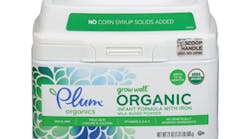The demand for food manufacturers to enhance nutritional profiles of children's products is rising, and parents want more vitamin and mineral fortification as recommended by the Dietary Guidelines.
The children's foods market climbed to $6.9 billion in 2016. With an increase in the birthrate, Mintel predicts the market for convenient, healthy baby/toddler and children's food and drinks will continue its steady growth.
But balancing children's needs and wants with the interests of their parents isn't child's play. Parents are willing to pay a premium for better-for-you foods, providing the quality meets their expectations and the child enjoys the flavor, Mintel notes. Higher-income parents have more available income to pay the prices organics and other premium products typically command, but such recession-hardened consumers are also aware that organic and clean-label claims are just as viable from less-expensive alternatives and private-label offerings.
Product developers are answering the call, forgoing production of softer, downsized versions of adult foods & beverages for kids in favor of more specialized, functional products with age- and stage-appropriate textures, flavors and nutrition.
After an extensive examination, the American Academy of Pediatrics (AAP) found that what kids shouldn't eat is as important as what they should. The AAP issued new recommendations in May advising parents to pull back on giving fruit juices to children of all ages. This update is the first in 16 years to the group's guidelines on fruit juice for kids.
Especially noteworthy was the academy's insistence that parents avoid giving fruit juice at all during a baby's first year of life. A cup of fruit a day may be given to children ages 1 to 4, with only up to 4 oz. of it from 100 percent fruit juice. Like soda, juice carries plenty of sugar and can contribute to an "energy imbalance," the AAP notes, alluding to the belief that too much juice can lead to obesity in children.
Likewise, government statistics say about one-third of kids aged 4 to 8 aren't getting enough calcium. Calcium is critical for developing bone mass, nearly all of which is built during childhood and adolescence. Being deficient can interfere with growth and increase the risk of osteoporosis later in life − especially for girls. An added bonus, many foods high in calcium are also high in vitamin D, which not only strengthens bones but may help prevent type 1 diabetes and other diseases.
Many food companies are fortifying products, such as cereals and frozen waffles, with vitamin D and calcium. Yogurt and smoothies are also good options if kids avoid drinking milk.
General Mills in late June and early July filed several patents for improving its ready-to-eat cereals. One focuses on replacing some of the sucrose in the coatings with maltotriose, maltotetrose and a high-intensity sweetener. Another improves the eating quality of puffed cereals fortified with dietary fiber and calcium, removing a sometimes gritty taste and uneven surface appearance. The company also has been on a multi-year mission to add more whole grain to several brands.
Improving products for the children's market is great, but skeptical parents want proof.
"Creating products that meet the demand for supporting children’s health and wellness through functional foods can help improve market share. But consumer demand also calls for safe, natural and clinically proven ingredients in products that taste great, appealing to family lifestyles and picky eaters," observes Molly Fitzgerald, senior digital communications manager for Wellmune, an immunity-enhancing ingredient from Kerry Functional Ingredients & Actives (www.kerry.com), St. Paul, Minn.
"Manufacturers should seek functional ingredients that can not only be easily incorporated into their food products but also supported by clinical research," she continues. "Research is an important part in the understanding of how a functional ingredient works. It helps earn credibility among consumers and provides validation by demonstrating a product’s proven benefits."
Iron quotient
Starting infants on solid food after about 6 months (when their teeth begin to come in) provides them with a source of iron as their internal stores from breast feeding decrease. Getting enough iron, phosphorus, potassium and magnesium — primary muscle and bone-building components — as well as vitamin C, K and omegas can be next to impossible if kids don't like what they're tasting. Whole wheat bread, lentils, beans, raisins, lentils, soy nuts and tomato paste are good sources of iron (vitamin C-rich foods can also increase iron absorption).
Likewise, Jennifer and Johnny Kien, founders of Canada's Keen Bean (www.mykeenbean.com), Winnepeg, Manitoba, focused on incorporating iron-rich ingredients when developing their cold-pressed, organic baby food blends, both to set them apart and to align with Canadian governmental recommendations to introduce iron-rich ingredients in foods for children 6 months and up.
Some food companies are going strictly organic in formulations for children's and infant foods, as the organic category surged 20 percent in 2016, according to Innova Market Insights. Plum Organics (www.plumorganics.com), Emeryville, Calif., now owned by Campbell Soup Co., last year added the Grow Well organic brand of infant formula to its product lineup. Using organic lactose as its only carbohydrate instead of corn syrup solids, the formula is made with organic plant-based oils, organic nonfat milk and organic whey protein, and it contains no GMOs.
The formula contains milk from cows not treated with rBST plus organic lactose, DHA (docosahexaenoic acid, an omega-3 fatty acid that supports brain and eye development) and ARA (arachidonic acid, an omega-6 fatty acid) , kosher dairy and no gluten or corn syrup solids.
"As a working mom who intended to exclusively breastfeed, I remember how anxious I felt when I couldn't produce enough milk and had to turn to formula. That's why this launch is personal for me," said Larissa Friesen, Plum's infant formula lead. "At the time, there weren't a lot of organic options out there I felt comfortable feeding my son. Many parents think of formula as medicinal and clinical, but formula is food – cow's milk is the primary ingredient. We're uniquely positioned to create a high-quality organic formula that parents, including us, can feel comfortable feeding their tiny ones."
With kale's emerging popularity for its nutrient-rich benefits, many parents ask pediatricians if kale can be fed to infants or toddlers. The answer is yes, if they'll eat it. According to the national nutrient database from the USDA, kale, which belongs to the cabbage and cauliflower group, is high in iron, potassium, calcium, vitamin C and A, and can be safely fed to infants or toddlers at least 8-9 months old. There are few risks, however, as kale's high potassium levels should be avoided for those whose kidneys aren't functioning properly. The iron and vitamins in kale are what make it a superfood, and it has more calcium than milk.
HappyFamily offers several kale-containing products, such as an apple-kale-avocado variety in its HappyBaby Clearly Crafted organic line of baby food in clear squeeze pouches. The sweet and savory green puree incorporates U.S.-grown kale with vitamin A. The leafy green superfood teams with organic avocados and apples to balance the flavors and textures for the exploratory taste buds of Stage 2 eaters. The company's Homestyle Meals for 6-month olds and up include a version with apples, raspberries, kale and amaranth.
ABCs of DHAs, probiotics
HappyFamily points out there are many essential nutrients for babies and toddlers, including DHA, which can be found in cold-water fish like salmon, walnuts, canola oil and fortified foods -- like its HappyBaby probiotic cereal and select Happy Tot pouches. The medical community cites DHA omega-3 fatty acids as crucial for the development and function of the brain, eyes and heart. An optimal intake of DHA is essential for pregnant and nursing mothers to ensure adequate brain development in their children.
Much like omega-3 fatty acids, probiotics have been used to support immunity and address everything from cholesterol levels to skin problems. Studies suggest probiotics can enhance the absorption of omega-3 and increase body-wide omega-3 tissue levels. Pre- and probiotics found in yogurt, breast milk and fortified pureed foods (like HappyFamily's HappyBaby Yogis) support immune function and digestive health.
Probiotics have become increasingly popular in infant and older children's products as awareness rises about the importance of boosting beneficial bacteria from the start of life. Babies are born with sterile digestive tracts, and a variety of factors can affect the natural gut flora and the development of their digestive systems, says Ganeden Inc. (www.ganedenprobiotics.com), maker of the BC30 strain of probiotics, the first to receive FDA approval as being generally recognized as safe (GRAS) to use in infant formulas.
"Whether a baby is bottle fed, delivered via C-section or has to be put on antibiotics, all adversely affect their GI system," explains David Keller, vice president of Ganeden's scientific operations. As immune health is a top priority for parents, the company is also targeting children’s products for its new Staimune probiotic technology for the immune health category in foods, beverages and companion animal products. Utilizing the cells of GanedenBC30 to support immune health at what Keller says are cost-effective inclusion levels, Staimunie will be available at the end of this summer.
"With the increase of C-sections over the past 50-plus years along with other factors, babies are more susceptible to obesity, diabetes, a weakened immune system and poor digestive health," Pergament says. "This, coupled with the over-prescription of antibiotics to infants and children, has made it necessary for parents and pediatricians to recognize there is real need for babies and children to take prebiotics and probiotics to help balance out these negative factors."
Sugar's link to asthma and allergies
Because sugar is increasingly being linked with various diseases, including diabetes and obesity, more research is being conducted on its affects on children's health. A July study published in the European Respiratory Journal shows pregnant women who consume too many sugar-sweetened foods and drinks may be increasing their children's risk of developing an allergy or allergic asthma.
The children of women with highest sugar intake during pregnancy had a 38 percent higher risk of allergy diagnosis, the researchers calculated. According to the World Health Organization, 235 million people have asthma, a common disease among children. That number is expected to rise to 400 million by 2025.
"The dramatic 'epidemic' of asthma and allergies in the West in the past 50 years is still largely unexplained − one potential culprit is a change in diet," said Annabelle Bedard, lead author and a postdoctoral fellow at Queen Mary's Centre for Primary Care and Public Health Blizard Institute. "Intake of free sugar and high-fructose corn syrup has increased substantially over this period. The prenatal period may be crucial for determining risk of asthma and allergies in childhood, and recent trials confirmed that the maternal diet in pregnancy is important."
While added sugars should be minimized, carbohydrates and their glucose supply play important roles in cognitive functions. It's the type of carbohydrate that counts, points out Anke Sentko, Beneo's vice president of regulatory affairs and nutrition communication at Beneo (www.beneo.com), Morris Plains, N.J., "Starting the day with the right choice of carbohydrates can make all the difference in performance," Sentko says. "Children’s cognitive functions benefit most from the replacement of fast glucose-release carbohydrates with a slow and sustained glucose supply."
Beneo's functional ingredients experts focused a study last year on children's health, involving the functional carbohydrate called Palatinose isomaltulose. The non-cariogenic (kind to teeth) disaccharide-type sugar is a low glycemic variety and was shown to enhance mood and memory in school-age children.
Conducted at the Dept. of Psychology at Wales' Swansea University, the study assessed mood and cognitive performance in 75 school-aged children eating a breakfast of cornflakes, milk, yogurt, jam and orange juice, incorporating Palatinose or glucose (providing 41g of carbohydrate). Both groups of children initially did well right after breakfast, but those who ate the Palatinose breakfast maintained significantly better memory performance and were in a better mood later in the morning than those consuming the glucose-containing breakfast, both in immediate and delayed memory tests.
Impacts later in life
Diving deep into the children's obesity problem, Mead Johnson Nutrition (www.meadjohnson.com), Chicago, is participating in a scientific project studying the effects of early nutrition interventions on metabolic and brain development in infants and young children. Called BriteN, the four-year initiative, which includes research partners from the Donders Institute at Radboud University/UMC, Netherlands Organisation for Applied Scientific Research, Green Dino, Metris and Artinis Medical Systems, focuses on nutrition's role in impacting childhood metabolic syndrome and obesity and related effects on the brain and behavior. Tests will measure the cognitive development of kids and their risk of becoming obese and also assess gender differences.
"Nutrition during the early stages of life is not only important for healthy growth and development, but emerging science shows it also impacts health and disease later in life," explains Ric van Tol, head of the global discovery group at Mead Johnson Nutrition. The group hopes to find the most beneficial foods and nutrients during various developmental phases and measure their impact, which could stem the growing problem of metabolic syndrome, childhood obesity and other maladies associated with risks of high blood pressure, blood sugar and cholesterol levels.
The research will also encourage the development of innovative products to benefit children around the world. "For decades, we’ve been committed to making DHA available to children by adding it to our formulas because of its proven benefits for the brain – but our research isn’t stopping there," notes Dirk Hondmann, chief scientific officer at Mead Johnson. "The BriteN project will help meet the child obesity challenge by advancing our understanding of how specific ingredients and diets impact young children’s cognitive and metabolic development."


